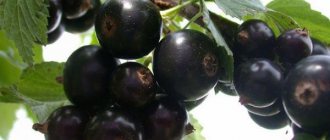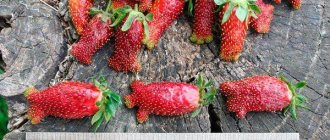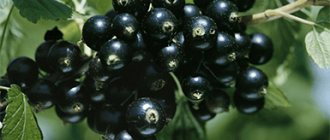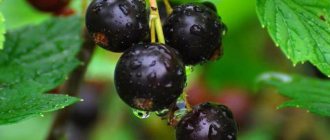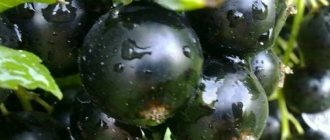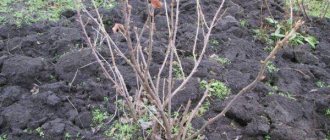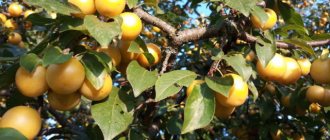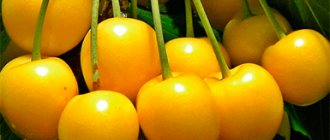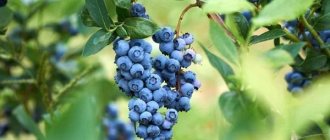Description of the variety
The variety was bred in 1970 by pollination with the Altai dessert variety Kajaanin Musta-Tamas. For many years, Titania remained the standard of taste and yield. This currant was propagated throughout Europe. It came to Russia two decades later - in 1990-1995. In domestic gardens, the variety showed all its abilities to the fullest and also became the most popular currant variety among not only private owners, but also farms.
The secret of the popularity of this type of currant lies in its incredible vitality. During testing, it was noted that Titania bushes tolerate frost and unfavorable conditions well and produce very good yields, while most other varieties cannot withstand the load of cold or heat - they reduce productivity and get sick. In addition, Swedish currants are unusually resistant to various diseases. Anthracnose, powdery mildew, white and brown spot - the most common diseases of this crop - almost never affect Titania.
Reference : the Titania variety is used by breeders to create new varietal varieties of black currants.
Characteristics of the variety
Titania is an early variety. Young plants begin to bear fruit in the second or third year of life. Their productivity increases until 5-7 years of age, and in subsequent years it decreases. The productive period lasts 12-15 years, depending on the soil, climate and care. Titania feels great on loose podzolic soils, and does not tolerate heavy clay soil, wetlands and high acidity.
Varietal currants have medium ripening periods. Flowering occurs at the end of May. Flowering duration is two weeks. Currant ripening occurs 40-45 days after the start of flowering. The first ripe berries are picked from the bush in mid-July. The peculiarity of Titania is its extended fruiting. Currants form and ripen unevenly, so the harvest period may take a month or a little more. The berries ripen every 10 days. The final yield indicators vary between 77-80 centners per hectare.
Fact : Titania currant is self-fertile.
The bushes are distinguished by their lush growth of shoots, are highly leafy and exude a wonderful currant aroma. The height of adult plants reaches one and a half meters. The crown is dome-shaped and voluminous. During the season, the bushes grow very much, so they require careful pruning in the fall.
The berries are collected in clusters of 20-25 pieces. At biological maturity, they are black in color with a slight glossy sheen. The skin is dense and elastic, so the berries can be stored for quite a long time (up to two weeks in the refrigerator). Ripe fruits do not fall off the bush and patiently await picking. The separation is dry.
The inside of the currant is green, juicy, but not watery. The taste is sweet and sour, with a wine aftertaste. Sugar content – 6.6%, acid 3.2%. Berries of uneven size. The weight of a medium-sized fruit is 2-2.3 grams. On a 5-point scale, the taste is rated 4.6.
Fact : Currants can be harvested by machine. The berries survive transportation without loss, which attracts farmers to grow for sale.
Berries have a universal purpose. They can be consumed fresh, made into drinks, jam, jelly, and used as a filling in pies and dumplings. They can even be frozen and dried.
Advantages of the variety
- consistently high annual yield;
- winter hardiness;
- immunity to disease;
- good keeping quality and transportability;
- long fruiting;
- ripe berries do not fall off the bush.
Minuses
- strong growth of bushes;
- the fruits have a sour taste;
- requirement for constant soil moisture;
- uneven berry size.
Landing technology
It is no secret to experienced gardeners that the choice of location for seedlings, as well as compliance with planting rules, affect the growth and development of the future shrub. When preparing a site for currants, take into account that the bush is capable of growing in one place for 10 to 15 years.
Selecting a location
For currants, choose open, illuminated areas along hedges or fences, with the necessary indentation for root growth. About 2 meters are left between the bushes so that the roots of the seedlings do not interfere with each other.
Currants prefer fertile loose soils and light loams. It is prohibited to plant young seedlings of Dacha in places where other varieties of currants or gooseberries had previously grown.
Recommended planting dates and patterns
Currant seedlings are planted in autumn or spring. It depends on the individual preferences of gardeners:
- spring planting begins long before the buds on the seedlings swell;
- In the fall, the bushes are buried in the soil so that before the first frost the roots have time to adapt and get used to the soil.
Preparing the planting hole and seedling
For a planting hole, dig a hole 40 centimeters deep, then fill the hole with a fertile mixture consisting of soil and complex fertilizers
When choosing a seedling, pay attention to the root system. The general condition of seedlings is assessed according to several criteria:
- the root system should not have dry areas or damage;
- the bush should consist of 2 or 3 stems;
- Viable buds must be formed on the shoots.
Planting rules
Currants are planted in a straight line along hedges or fences. A distance is left between the bushes for the growth of the fibrous root system. Between the rows of subsequent plantings there should also be space necessary for the design of the tree trunk circle, mulching and installation of fencing elements.
Features of growing black currants
The first varietal seedlings are purchased in fruit nurseries or in trusted places where they will definitely sell healthy and high-quality planting material. Titania seedlings should be long (up to 50 centimeters), flexible, with a well-developed root system, the length of which is at least 10-15 centimeters. All parts of the cutting must be free of damage, signs of disease, rot, and wilting.
Preparing the site and planting seedlings
The usual place for currants is around the perimeter of the site, along the fence. Growing in relative partial shade, away from other plantings, Titania feels excellent - this is reflected in its good harvest every year.
The best time to plant the crop is autumn, the first half of October. Spring planting, even in the earliest stages, gives worse results in terms of plant survival.
Before planting in the garden, the root system of berry bush seedlings is inspected, and only those roots that have severe mechanical damage are cut off. There is no need to update all the cuts - this is an operation harmful to currants. Before planting a currant cutting in a hole, the roots are dipped in a solution of clay and mullein. The upper part is cut off, leaving only two or three shoots 12-15 centimeters long with several developed buds.
Currants are planted in a large hole (40*40 centimeters) filled with fertilizers - ash, forest leaves, potassium chloride, superphosphate. The holes are sealed at a distance of two meters, since an adult currant bush grows very much and close planting can harm its productivity in the future. The roots of the seedling are placed there. Then the roots are covered with earth, periodically shaking the seedling and compacting the soil so that there are no voids left. The shrub should be buried 4-5 centimeters lower than it sat in the nursery. This is done so that strong shoots will grow from the root collar and part of the shoots covered with soil next year. At the end of planting, shallow holes are made around the plants, which are watered abundantly and then mulched with rotted manure, compost or peat.
Reproduction
The crop is capable of propagation by lignified cuttings or layering, or by green cuttings. The easiest way to obtain new specimens of currants is to root woody cuttings. To do this, cut 15-20 cm branches with 5-6 buds and plant them in well-prepared and fertilized soil. The cuttings are planted in an inclined position, at a distance of 15 centimeters from each other. Only one bud remains above the surface, which should be covered with mulch of humus, straw or peat chips.
It is optimal to plant cuttings in early autumn, but they can also be propagated in spring. The main thing is to constantly keep the soil where the cuttings are planted in a semi-moist state. By autumn, the rooted cuttings will be ready for planting.
When propagating by layering in early spring, before the leaves begin to bloom, one- to two-year-old branches are bent and pinned to the ground, placing the end of the layering at a depth of 6-7 centimeters. The branch is covered with earth. Young shoots growing from the branch spud. Layers are dug up only in September, cut into pieces and planted in a permanent place or for growing.
Care
Titania does not require special care. Agrotechnical techniques are the same as for other fruit and berry bushes. To keep the soil loose, moist and free from weeds, 5-6 loosening and weedings are carried out per season.
It is very important to carry out primary processing in early spring (late April - early May), and then during the period of active plant growth (late May) and in the post-harvest period (August-September) - for the incorporation of phosphorus and potassium fertilizers.
In the fall, it is imperative to loosen the soil around the bushes again, the tillage depth is up to 30 centimeters.
Trimming
Like any other berry bush, black currants must be pruned in order to:
- thin out the bushes and create good conditions for the growth of the main fruit-bearing branches and replacement basal shoots;
- replace all aging and unproductive branches with younger and more valuable ones;
- create a composition of branches of different ages to ensure uniform fruiting of the bush over the years.
A mature currant bush should have 15-20 branches, including approximately 4-6 annual basal branches, 3-4 two-year branches, 2-3 three-year, four-year and five-year branches.
First of all, cut out old, dried, damaged, broken branches, infected with fungus and pests, as well as those lying on the ground. All old branches with weak growth (shorter than 10 centimeters) are also removed. When thinning bushes, all less valuable branches that interfere with good circulation of air and light in the middle of the bush are removed.
When pruning young currant cuttings, all shoots are shortened, leaving a growth with 2-3 buds. In the second and third years, currant pruning is reduced to thinning the branches.
You may be interested in: Treatment of currants with copper sulfate in the spring from diseases and pests How to prune currants in the fall for a good harvest A simple recipe for red currant jam for the winter
Shrubs are pruned annually in the fall, after the leaves have fallen, before the onset of severe frosts and snowfall, and also in early spring, before the buds begin to bloom. Branches are cut at their base without leaving stumps.
Watering
Black currants especially suffer from lack of water. The harmful effects of drought can harm not only the current crop, but also the future. It is not difficult to keep currant plantings in relative humidity. Gardeners recommend sealing shallow holes in the tree trunk circle, into which water should be poured. If there is little precipitation, then the currants are watered in the amount required, based on its growing season. So, during the formation of ovaries, it is necessary to water more frequently. Currants are also irrigated abundantly after picking the berries. Before covering the currants for the winter, the bushes are watered again to retain moisture in the soil. Each bush requires up to 30 liters of water due to the peculiarities of the growth of the root system mainly deep into the soil (up to 50 centimeters). During drought, the crop is watered twice a week. If these waterings are not enough and the leaves droop, then the number of water treatments is increased.
Top dressing
Shrubs need good and regular fertilization. Every spring, nitrogen fertilizers are applied along the rows of plants to a depth of 10 centimeters for digging or loosening. Ammonium nitrate is applied to young seedlings. If the soil is too acidic, then the acid is “quenched” with lime.
Please note: liming of the area under currants is done in advance - two to three years before planting the crop.
In the fall, after harvesting and preparing the area for winter, humus and a little potassium sulfate and superphosphate are added to the soil under the bushes.
During the growing season, Titania receives foliar feeding consisting of complex mineral compounds.
Agricultural technology
Before landing, you need to decide on a place. Areas with slightly acidic soil and good aeration are ideal for black currants. Therefore, if the soil is heavy, you need to add sand or limestone to it.
Why doesn't black currant bear fruit?
The varietal shrub prefers flat areas in lowlands.
Important! The permissible groundwater level does not exceed 1 m. In a wetland, currants will often get sick and eventually die
In addition, do not forget that Titania requires a lot of light.
It should be taken into account that a bush with an open root takes root better if it is planted in the fall. Although spring planting is also possible. The main thing is to be in time before the buds bloom.
3-4 weeks before planting, you need to fertilize the soil. To do this, the soil is sprinkled with compost, nitroammophos and wood ash. If this is not done, you will have to apply fertilizer directly during planting, which is done as follows:
- first you need to form a hole measuring 40 cm in all directions;
- then pour 10 liters of clean water onto the bottom;
- lower the seedling at an angle, deepen the root collar by 6 cm;
- straighten the roots and cover them with soil;
- Form a hole around the plant, water it and mulch it.
Note! Experienced gardeners recommend choosing a longer seedling. At least 15 cm of the bush should remain above the ground
With the right choice of location and proper planting, you can count on uninterrupted fruiting for 11 years. But in order for the harvest to please you, you also need to take good care of the currants. What manipulations are necessary:
- Be sure to loosen the soil. This must be done with extreme caution so as not to damage the roots. The fact is that they are located very close to the surface of the earth;
- Water as needed. Most often you will have to do this during drought and during the flowering period. One bush requires at least 30 liters of water;
- Weed the area. Weeds take most of the nutrients and moisture from the soil. Therefore, you need to get rid of excess vegetation in a timely manner;
- Trim old branches in spring. They need to be removed before the buds open. For the first 3 years, in addition to removing dry shoots, it is necessary to form a bush. To do this, the 5 strongest branches are left annually, and last year’s branches are reduced by 3 buds. As a result, by the age of 4 the currant will consist of approximately 20 branches.
Don't forget about feeding. Loosening is a great opportunity to add a little urea (30 g is enough). In autumn it is better to fertilize with the following components:
- humus – 5 kg;
- potassium sulfate – 20 g;
- double superphosphate – 40 g.
Plus, you can add mixtures for foliar fertilizer. Products with nitrogen, phosphorus, potassium and other microelements are ideal.
Mixtures for foliar fertilizer
Protection from diseases and pests
Titania bushes rarely get sick. Usually weak plants that are constantly waterlogged or, conversely, living in dry soil are affected. The development of diseases is also affected by a lack of fertilizers.
In general, to maintain berry bushes in health and relative safety from ubiquitous insect pests, exclusively preventive measures are needed. This includes timely watering, pruning dry and diseased branches, and clearing the area of old leaves in which harmful microflora multiply.
In the spring, before buds begin to bloom, currant bushes are sprayed with 6-8% emulsion of carbolineum or green oil against scale insects, aphids, copperheads, mites, leaf rollers and other pests.
During flowering, all garden plants are treated with Bordeaux mixture. If currants are damaged by mites, the bushes are sprayed with a lime-sulfur decoction.
To combat pests, it is enough to have the most important pesticides on the farm: copper sulfate, lime, dust, chloroethene, nicotine sulfate.
Plant care
In spring, the upper parts of the shoots are cut off by 1–2 cm. It is allowed to remove branches from the top by 3–4 buds. Pruning makes it possible to form a bush, provokes the growth of side shoots and increases productivity.
Additionally, old and diseased branches are pruned. After pruning, 5–6 young and strong shoots are left. The formation of the bush continues for three years. An adult plant has no more than 16–25 branches.
Pruning is carried out once a year, but some gardeners prune the bush a second time in the fall. In the fall, it is recommended to cut out only those bushes that need renewal.
In early spring, before the buds awaken, it is a good idea to water the plant with boiling water. This will destroy still dormant parasites and protect the bush from diseases. It is necessary to water the bush at a time when the snow has not yet completely melted. The buds should not wake up, otherwise the boiling water will damage the young foliage. Boards or plywood are placed under the plant to protect the roots from hot water.
In April, the bushes are additionally treated with fungicides. Feeding is carried out with mineral and organic fertilizers. Rotted horse manure will do.
In the summer, nettle infusion works well as a top dressing. After the awakening of flower buds, treatment with toxic substances against parasites is not recommended.
In spring, the soil under the bushes is dug up and 30 g of urea is added.
In the fall, after cutting out old branches, the following composition is added to the soil under the roots:
- humus 4–5 kg;
- potassium sulfate 20 g;
- superphosphate 40 g.
Titania tolerates dry and hot seasons well, but do not allow the soil to dry out. Watering is recommended every 3-4 days. When overwatered or in rainy summers, the berries acquire a sour taste.
The bush feels good in one place for at least 15 years. But once every one or two years, old shoots are removed. The plant is rejuvenated. For the appearance of young shoots in the spring, a side shoot is dug in. Over the summer it will take root and young shoots will appear.
Preparing for frost
In regions with cold winters, additional preparation is necessary. Around the bush, the soil is covered with sawdust or a mixture of black soil and sand (½) to a depth of 10 cm.
In regions with high rainfall, bushes are bent to the ground and tied with wire. The branches are covered with slate or a piece of plywood or boards on top. This will protect the branches from breaking.
It is permissible to wrap the branches with agrofibre or other insulation. But the process is labor-intensive, since each branch is closed separately.
You cannot use polyethylene or other airtight material for wrapping; the plant will rot under such protection.
https://youtube.com/watch?v=dYYNCcXrt0E
Collection and storage of berries
Berries begin to form at the end of July. But if the weather permits, the first ripe fruits will appear a little earlier.
The variety is characterized by long wave-like fruit formation, which lasts until the end of August. The berries slowly and gradually form in clusters and also ripen. During the season you can collect 3-4 waves of harvest. Thanks to this feature, you can enjoy fresh fruits right up to the fall, without rushing, making preparations for the winter. The remainder of the harvest is usually frozen.
Uneven ripening of berries has a number of advantages: firstly, there is no need to additionally plant late varieties of currants in the garden; secondly, ripe berries can hang on the branches for a long time without falling off and they can be collected along with the rest of the berries, which will ripen a little later. The collected fruits are perfectly stored due to their hard skin.
Titania blackcurrant is a variety that is not suitable for everyone. It can be off-putting due to its uneven and overly extended fruiting and the variety of berries. Not every gardener will like sour fruits. However, those who prefer more sourness in taste will appreciate the high yield of the bushes and their extraordinary endurance.
How to plant
There are different ways to plant Titania currants on your site. It can be propagated by cuttings or layering. But it is best to buy a good seedling in a specialized agricultural store or at the market.
However, this variety takes excellent cuttings . The shoots of this currant grow well, so you can select the necessary material and propagate the plant using cuttings.
Titania currants are planted in autumn or spring. But many gardeners prefer autumn planting. Since over a longer period of time it is good for the root system to strengthen in its new habitat. But in early spring, after the snow melts, the plants will begin to grow intensively.
If you decide to plant currants in the spring, it is best to do this at the end of March, when the buds are still dormant. It is best to plant currants on the south side in a well-lit place. Do not allow drafts to appear in the area; currants do not like them. It is better to plant bushes near any buildings or near a fence.
